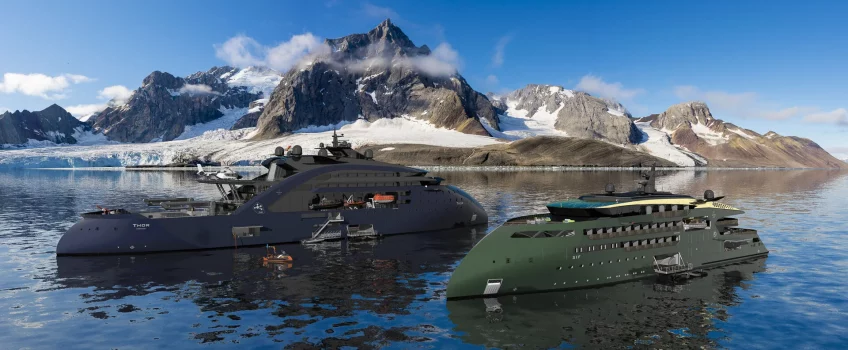
Electric boat building has become big business in the maritime sector with the latest vessel, Thor, using a thorium molten salt reactor. At first glance, it somewhat resembles a vessel you’d expect a James Bond villain to have. Unveiled by Norwegian maritime solutions company, Ulstein, this new electric boat concept has tremendous potential to bring us zero-emission cruises and other marine applications. With everything they’ve put on board, it can be used for research, rescue, and replenishing missions among others.
Ulstein Helping To Electrify Maritime Transport
Ulstein Group is a Norwegian family-owned firm founded in 1917 that specialises in ship design and solutions, shipbuilding, international sales and shipping. Their vision is “to create tomorrow’s solutions for sustainable marine operations”.
With all that experience in electric boat design, shipbuilding and delivering sustainable maritime solutions, Ulstein is fast becoming a leader in its field. They are leading the proverbial charge in the decarbonisation of the maritime industry with a brilliant solution; a molten salt reactor or MSR.
How Does The Electric Boat Work?
To produce electricity, Thor’s molten salt reactor uses a naturally occurring element with low levels of radioactivity. This natural element is thorium, which is actually more abundant in nature than uranium. Using thorium as a primary energy source has been an exciting prospect for many years and it seems Ulstein is taking big leaps.
Thorium is usually dissolved in molten salt with the subsequent chain reaction heating up the salt to produce steam. This is then used to drive turbines and produce electricity with zero emissions. While MSRs have been used to generate power on land, as is the case with China’s thorium-nuclear reactor, it hasn’t been done at sea, until now. Ulstein’s new electric boat concept may serve as a blueprint for producing future self-sufficient electric vessels.
What Can Thor Do?
This next-gen electric boat can perform rescue missions as it has everything you will ever need. This includes helipads, autonomous surface vehicles, airborne drones, cranes, workboats, rescue booms and firefighting equipment. To perform research functions, Thor will also be equipped with laboratory spaces and a lecture lounge.
However versatile Thor is, the primary focus of the electric boat will be its replenishment role. It will be expected to power expedition cruises in remote and environmentally fragile areas. According to Ulstein, they’ve upscaled Thor’s charging capacity to meet the needs of up to four expedition cruises while also powering itself.
Specifications Of The Thor Electric Boat Concept
The Thor electric boat concept was recently unveiled at Seatrade Miami and for demonstration purposes, Ulstein developed an Ice Class expedition vessel called SIF. At 328 feet (100 metres) long and powered by next-generation batteries, this vessel has a capacity of 160 members (80 crew and 80 passengers) with the added benefit of treading the Arctic and Antarctic waters. This Ice Class 1C electric boat will use next-generation batteries while utilising ‘Thor’ to recharge at sea for continuous operational capabilities.
According to Jan Emblemsvåg, an expert in the field of thorium and nuclear power generation; “MSRs have enormous potential for enabling clean shipping. There is so much uncertainty over future fuels, but here we have an abundant energy source that, with the right approach, can be safe, much more efficient, cheaper, with a smaller environmental footprint than any existing alternative.”
The Electric Boat For Decarbonisation
Decarbonisation of the maritime sector is already in full swing with the UK publishing its Clean Maritime Plan in July 2019, becoming one of the first countries to publish a national action plan. It essentially describes the UK’s roadmap to clean growth for the maritime sector and plans to achieve zero-emission shipping. The electric boat has seen a revival recently as conversions and new builds are delivering promising results in the reduction of fuel use, lower emissions, vibrations, noise and operational costs. While the initial cost is still relatively high, demand is increasing which will eventually lead to a decrease in costs.
Conclusion
While electric and hybrid vessels are not new concepts in the maritime world, the latest developments, including this remarkable electric boat from Ulstein, are proving that this technology is a viable option now.
Ulstein CEO Cathrine Kristiseter Marti stated: “We have the goals, ambition and environmental imperative to switch to zero-emission operations, but, until now, we haven’t had the solution. We believe ‘Thor’ might be the answer we’ve been looking for. ‘Thor’ is essentially a floating, multi-purpose ‘power station’ that will enable a new battery revolution.”
PRV Engineering works closely with several industries including maritime, oil and energy, aerospace, defence, construction and rail. We work with basic mild steels to the more exotic Monel, Inconel, Hastelloy and Titanium providing one-off projects, large batch production or Rapid Prototyping.


 Mail:
Mail: 



